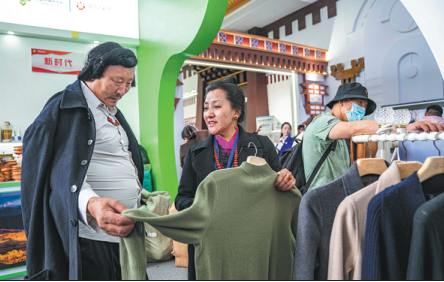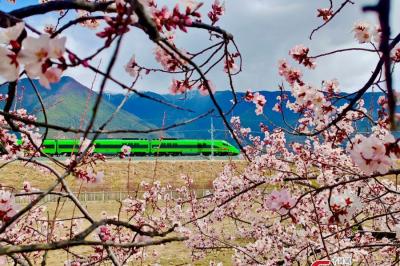Tibet is not only a place with snow-capped mountains, vast grasslands and ancient culture, but a place that combines butter tea with wine, Tibetan Opera with Peking Opera and tradition with modernity. While locals attended the fifth Xizang Tourism and Culture Expo in Lhasa from June 16-18 for foreign goods, tourists were there to enjoy Tibet's culture. Sun Lu is a tourist from Beijing. She said Tibet has its unique tourism resources and "many of my friends and I think one should make a tour of Tibet at least once in life". Sun had a 10-day trip in Tibet and attending the expo was part of her itinerary. She visited many sections, saying that the exhibitions of Tibet's thangka paintings, woodblock printing, Tibetan calligraphy and creative products derived from local culture were the most attractive. There were also shows of Tibet's specialty food. Sun said when she was approaching "the Taste of Tibet" exhibition hall, she was treated to a cup of sweet butter tea. "To please one's taste buds is the first step to win one's heart," said Fan Kun, a staff member in charge of the food exhibition. He added that authentic Tibetan food varieties, like highland barley beer, tsampa toasted flour, butter tea and others, are a draw for tourists to Tibet. During her visit, Sun said she was impressed with the multimedia demonstration of Tibet's attractions and recommended touring routes at the tourism exhibition hall. "This demonstration is especially helpful for people to make their tour plans," Sun said. An official from the Tibet Tourism Development Department said the multimedia demonstration covered all the major elements of Tibet's tourism industry. These include sightseeing, recreation, entertainment, dining, accommodation, transportation and shopping. As the expo was held both offline and online, the officials said that the event can make Tibet better known to tourists worldwide, in terms of tourism resources and the levels of its services and infrastructure. Tibet has achieved great development in its tourism industry over the past decade. It received more than 288 million tourist visits from 2012 to 2022, garnering a total tourism revenue of 375.25 billion yuan ($51.78 billion) and creating jobs for more than 417,500 people, according to local statistics. Zhang Ding, a tourist from Shaanxi province, was visiting Tibet when the expo was held. He said he is a witness to the development of Tibet's tourism industry because this was the second time he had visited the autonomous region. Compared with his first trip 10 years ago, Zhang said he sensed the great changes in Tibet. "I drove all the way from Shaanxi to Tibet this time," Zhang said. "I found the roads are upgraded, the cities are better developed and the services are improved." The three-day event is also a platform to display the all-around development of Tibet through the exhibition of local products. Sichod Drolma was a sales representative at the expo, displaying and selling cashmere products made by a cooperative in Tibet's Ngari prefecture. She showed a sweater to a visitor at her booth, explaining that the product is made of top-quality local cashmere produced with world-class techniques. "Known for its lustrous look, fine fibers, good resilience and excellent performance in keeping warm, Ngari's cashmere is usually referred to as 'soft gold'," she said. She explained that the quality of local cashmere is related to the natural environment of Ngari, which is about 1,500 kilometers away from Tibet's capital city of Lhasa. "Tibet is called the 'roof of the world', and Ngari is definitely the 'roof of the roof' as it is the highest prefecture in Tibet," Sichod Drolma said. "Goats there have developed unique hair — the best cashmere — to keep warm in the cold weather of Ngari." Despite the abundance in top-quality cashmere, Ngari had not been able to develop an advanced cashmere production industry in the past due to its underdeveloped transport and farmers' inability to run modern, competitive productive enterprises and marketing operations. But many changes have taken place during the past decade. More roads have been built and improved, and rural cooperatives and advanced plants have now emerged in Ngari. "The cashmere production cooperatives now bring goat farmers together, assisting the industry's development with better means to access funding and marketing channels," Sichod Drolma said. "And businesses from the rest of country have come to Ngari to invest in advanced production facilities, helping the local industry expand to domestic and international markets." Xinhua contributed to this story. A female sales representative of a Tibetan company presents cashmere clothing to a man during the expo. SUN FEI/XINHUA |
- Home
- News Tibet |Exclusive |China |World |Related News |Latest
- Documents White Papers |Others
- Photo Politics |Economy & Society |Culture & Religion |Human & Nature |Beautiful Tibet |Other Tibetan-Inhabited Area |Exchanges |Related
- Video News |Documentary |Micro-Video |Entertainment
- Art
- Tourism
- In Focus
- About Tibet







